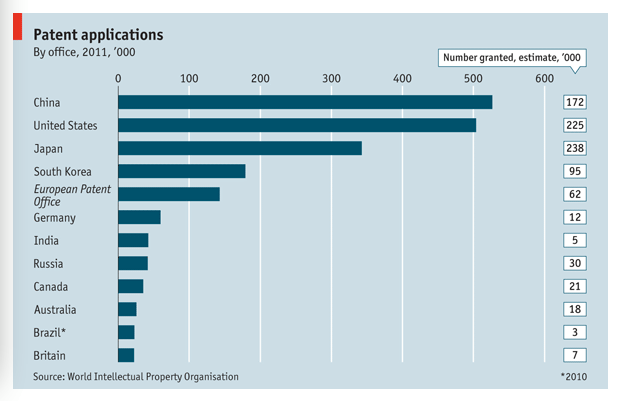The event will be held one day before the Economic Freedom Network (EFN) Asia 2014 conference, Among the cool reading materials are these.
The Global IP Center (GIPC) of the US Chamber of Commerce published a few months ago The International Intellectual Property Index, 2014 Report. Only 25 countries were covered though, the Philippines not one of them. Perhaps in the coming years.
Here is the overall result, global ranking of the countries included.

The GIPC Index consists of 30 indicators divided into six major categories. Each indicator is scored between 0 and 1. The maximum available score for the entire index is 30.
Category 1: Patents, Related Rights, and Limitations
1. Patent term of protection
2. Patentability requirements
3. Patentability of computer-implemented inventions
4. Pharmaceutical-related patent enforcement and resolution mechanism
5. Legislative criteria and use of compulsory licensing of patented products and technologies
6. Patent term restoration for pharmaceutical products
7. Regulatory data protection term
Category 2: Copyrights, Related Rights, and Limitations
8. Copyrights (and related rights) term of protection
9. Legal measures that provide necessary exclusive rights that prevent infringement of copyrights and related rights (including Web hosting, streaming, and linking)
10. Availability of frameworks that promote cooperative action against online piracy
11. Scope of limitations and exceptions to copyrights and related rights
12. Digital rights management legislation
13. Clear implementation of policies and guidelines requiring proprietary software used on government
information and communication technology (ICT) systems to be licensed software
Category 3: Trademarks, Related Rights, and Limitations
14. Trademarks term of protection (renewal periods)
15. Non-discrimination/non-restrictions on the use of brands in packaging of different products
16. Ability of trademark owners to protect their trademarks: requisites for protection
17. Legal measures available that provide necessary exclusive rights to redress unauthorized uses of trademarks
18. Availability of frameworks that promote action against online sale of counterfeit goods
Category 4: Trade Secrets and Market Access
19. Protection of trade secrets
20. Barriers to market access
Category 5: Enforcement
21. Physical counterfeiting rates
22. Software piracy rates
23. Civil and procedural remedies
24. Pre-established damages and/or mechanisms for determining the amount of damages generated by infringement
25. Criminal standards including minimum
26. Effective border measures
Category 6: Membership and Ratification of International Treaties
27. World Intellectual Property Organization (WIPO) Internet Treaties
28. Singapore Treaty on the Law of Trademarks
29. Patent Law Treaty
30. At least one free trade agreement with substantive and/or specific IP provisions such as chapters on IP and separate provisions on IP rights provided it was signed after World Trade Organization/ TRIPS membership.
In Asia, only China, Indonesia, India, Japan, Malaysia, Singapore, Thailand and Vietnam were included, and four of them are in the bottom -- Indonesia, Vietnam, Thailand and India.
 Here is another data from the World IP Office (WIPO), shared by WEF in their fb page. In terms of patent applications, a number of big Asian countries are on the top, they realize the value of IPR protection and its contribution to a more innovative, higher productivity economy. This data seems to contradict the GIPC Report although the latter covers all aspects of IPR while the WIPO data covers only patents.
Here is another data from the World IP Office (WIPO), shared by WEF in their fb page. In terms of patent applications, a number of big Asian countries are on the top, they realize the value of IPR protection and its contribution to a more innovative, higher productivity economy. This data seems to contradict the GIPC Report although the latter covers all aspects of IPR while the WIPO data covers only patents.China’s move from imitation to innovation has been a matter of national policy in recent years. In 2011, for example, the government established a set of ambitious targets for the production of patents. Almost immediately, China became the world’s top patent filer.
China soon surpassed the US in other important measures. Each year, Chinese universities award more PhDs in science and engineering than US institutions do – and more than twice as many undergraduate degrees in these fields.
Moreover, China is set to outpace the US in investment in research and development. Since 2001, China’s R&D expenditure has been growing by 18% annually and has more than doubled as a share of GDP. In the US, that ratio has remained relatively constant.
...statistics from the US National Science Foundation reveal a genuine drive to innovate across much of Asia, with East, South and Southeast Asian countries together spending more on R&D than the US. And technology-intensive activity in the region is fast approaching that of North America and Western Europe.
Indeed, despite territorial disputes and other divisive issues, the commissioners of the patent offices of Japan, South Korea, China and, to a lesser extent, Singapore and Taiwan meet often to define and coordinate their intellectual-property (IP) policies. China’s leaders know that they can learn from countries like Japan and South Korea, which implemented policies to encourage innovation and protect IP rights long before China did.
This is good news. The territorial dispute and packing up of armaments seem to be exaggerated by some sectors and the mainstream media.Underneath are many avenues for peace and commerce -- more global and regional trade, in both goods and services, like IPR and innovative products and processes.
More innovation will spur more global commerce and trade. And that should mean less likelihood of any regional war.
------------See also:
On IPR abolition 16: Debate with Teddy Boy Locsin, August 24, 2012
On IPR Abolition 17: Copyright by a Government Corporation, September 07, 2013
On IPR Abolition 18: Patent, Copyright and Jeffrey Tucker, May 15, 2013
IPR and Medicines 27: More on Glivec and India's SC Decision, April 02, 2013
IPR and Medicines 28: Politicizing Innovation, Rewarding Rent-Seeking, April 06, 2013
IPR and Medicines 28: Politicizing Innovation, Rewarding Rent-Seeking, April 06, 2013
IPR and Medicines 29: Parallel Importation and Patent Linkage, August 19, 2014
